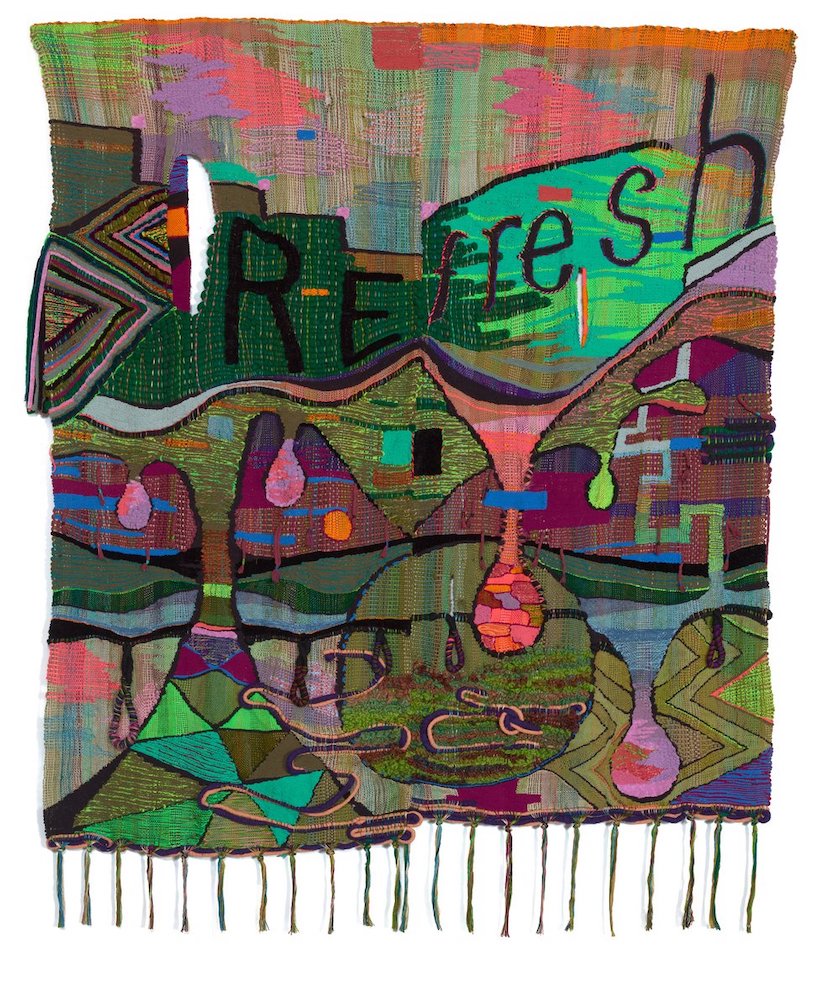Terri Friedman’s wonderful woven tapestries are on display in “tomorrow is just a thought,” the artist’s solo exhibition at Shoshana Wayne Gallery. Friedman has been creating her “yarn paintings”—applying formal principals of color, shape, and texture to her compositions as if they were traditional “paintings”—for years, and her stunning installation showcases these works and a new series of woven “portraits” each titled after a different feeling or emotion. Her works respond to internal and external uncertainty, and she presents positive possibilities through bright colors, unusual materials, and open-ended, non-objective abstraction. While some of the compositions contain words, they are meant to be suggestive rather than didactic. Friedman’s visual emphasis on positive suggestions is indicative of her interest in neuroplasticity—the capacity humans have to reshape their brains toward a more optimistic outlook, which she cites as one of the motivating forces behind her endeavors.
REFRESH (2022) is a large tapestry of undulating forms and shades that resemble a mountain landscape or seascape dotted with droplets that dangle above zig-zagged and cross-hatched lines. Woven areas of green, pink and purple overlap with one another beneath dark stitches that spell out the word “refresh.” The five-panel composition What can go right (2023) filled with floral imagery that is reminiscent of children’s renderings of gardens. Trees and flowers populate the mostly yellow-hued background filled with swirls, circles and triangles that recede into a distant landscape. The more abstract tapestry, Sometimes OK is good enough (2022), features eye-shaped ovals at the composition’s top, nested within which are the letters “O” and “K,” which exude an aura of positivity. Though busy and frenetic, the soft colors and suggestion of facial features offer a sense of calm and encouragement.

Terri Friedman, Homesick, 2023. Courtesy of Shoshana Wayne Gallery.
In the back of the gallery are seven works by Friedman in which faces depicting “elevated states of emotion” fill the small tapestries. Though brightly colored, they are messy, confrontational and a bit disconcerting. In Whoa (2023), a deep purple background surrounds the lighter purple and green face of a man with black hair, magenta eyes and an open mouth. Outlined in yellow thread, the is actually a hole in the weave. To the right of the mouth is a stained glass inset in the shape of a tear that echoes the golden tears that fall from the figure’s eyes. The tapestry Homesick (2023) exudes sadness. Here, Friedman weaves the head of a girl with black hair—a curl on one side and four different length dreadlocks on the other side of her face. Her open mouth shows her gritted teeth. She has one open blue eye with dark purple eyelids. The other, a weave of dark red and yellow threads, is vacant, held open by a vertical piece of stained glass that creates a void beyond it. The figure in Atonal (2023) spews multi-colored threads from their mouth that dangle at the right edge of the composition, whereas the two heads in Ditto (2023) are mirror images of each other. The space between their multi-colored and thickly textured faces is an abstract gradient filled with orange, pink and yellow.
Though at first glance, Friedman’s tapestries appear unwieldy, they are thought-out compositions she finds calming to fashion. The tension between the process of making and viewing gives the works a commanding presence. They are colorful, gestural, soft, tactile, beautiful and disturbing all at once. They catch your eye and hold your gaze, engaging with the language of painting and textiles on complex and multiple levels.


